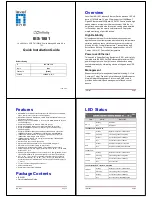
PMG2006-T20A User’s Guide
150
C
HAPTER
30
Diagnostic
30.1 Overview
The
Diagnostic
screens display information to help you identify problems with the PMG2006-T20A.
A connectivity fault point generally takes time to discover and impacts subscriber’s network access. In
order to eliminate the management and maintenance efforts, IEEE 802.1ag is a Connectivity Fault
Management (CFM) specification which allows network administrators to identify and manage
connection faults. Through discovery and verification of the path, CFM can detect, analyze and isolate
connectivity faults in bridged LANs.
30.1.1 What You Can Do in this Chapter
• The
Ping & TraceRoute & NsLookup
screen lets you ping an IP address or trace the route packets take
to a host (
).
30.2 What You Need to Know
The following terms and concepts may help as you read through this chapter.
How CFM Works
A Maintenance Association (MA) defines a VLAN and associated Maintenance End Point (MEP) ports
on the device under a Maintenance Domain (MD) level. An MEP port has the ability to send
Connectivity Check Messages (CCMs) and get other MEP ports information from neighbor devices’
CCMs within an MA.
CFM provides two tests to discover connectivity faults.
• Loopback test - checks if the MEP port receives its Loop Back Response (LBR) from its target after it
sends the Loop Back Message (LBM). If no response is received, there might be a connectivity fault
between them.
• Link trace test - provides additional connectivity fault analysis to get more information on where the
fault is. If an MEP port does not respond to the source MEP, this may indicate a fault. Administrators
can take further action to check and resume services from the fault according to the line
connectivity status report.
Summary of Contents for PMG2006-T20A
Page 11: ...11 PART I User s Guide ...
















































